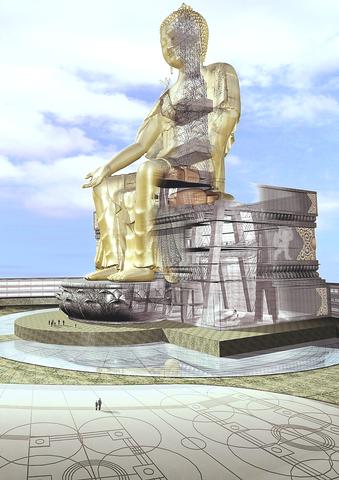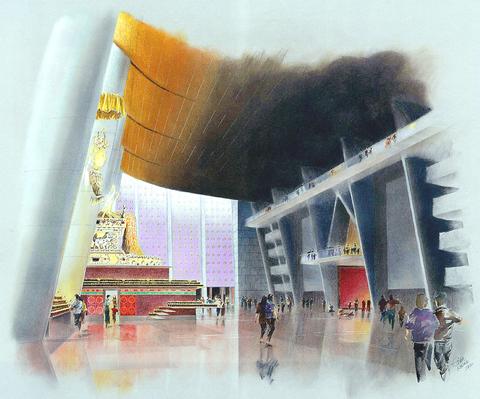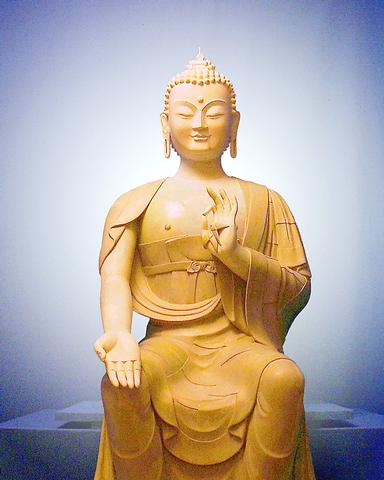It would be difficult to guess that the small office of Maitreya Project International (彌勒大佛工程台灣辦事處), hidden away in the warren of alleys off Nanking East Road Section 4, was an important cog in an international project to build the biggest Buddha statue in the world. Their presence is unremarkable, but their ambition, to erect a statue that will stand 152.4m tall in the town of Bodhgaya, India, is enormous.
Taiwan's participation in the project goes far beyond the country's small size and isolation, being the source of over one third of the funding.
"The largest supply of funds comes from the US," said Peter Kedge, the director of the project, "but Taiwan's contribution has been over 30 percent."

PHOTO COURTESY OF THE MAITREYA PROJECT
"The very idea to make the image so big came from an architect in Taiwan," Kedge said, adding that they settled on the round number of 500 feet (152.4m) during a visit by Lama Thubten Zopa Rinpoche to Taiwan five years ago.
Lama Zopa is the spiritual director of the Foundation for the Preservation of the Mahayana Tradition, a leading sponsor of the Maitreya Project. Since that visit, many Taiwanese have donated money and time to the project. Kedge said Taiwan had played an important role in sustaining Buddhism, in large part because of its considerable financial resources. "From my observation, when Taiwanese make a commitment, they make it with directness."
While declining to name any names, Kedge said that much of the support came from individuals rather than institutions. According to Monica Choying, at an event last November during a visit by Lama Osel, who is believed to be the reincarnation of Lama Yeshe, the initiator of the Maitreya Project, the organizers raised US$100,000 in a single evening.

PHOTO COURTESY OF THE MAITREYA PROJECT
Kedge, an engineer who has worked extensively in the UK and Hong Kong, is one of a growing number of Western Buddhists active around the world in the name of the religion. "Thirty years ago, when I first became interested in Buddhism, you could find perhaps five or six English books on the subject [in bookstores in Nepal]. Now there are thousands of titles available," Kedge said.
He said no definitive figures were available on the number of converts to Buddhism, but pointed to the huge increase in publications as proof at least of growing interest.
For this reason, the Maitreya Project has been careful to avoid associations with any one country or sect within Buddhism. While the inspiration for the project came from Lama Thubten Yehshe, the statue that he proposed is intended to express the qualities of the Maitreya Buddha -- compassion and living kindness -- for people of all sects. Kedge pointed out that, probably for the first time in such a project, much of the artistic work will be carried out by people not of Asian decent. "I am glad we chose British contemporary religious artists," Kedge said, adding that the Buddha would adhere to the traditional proportions, but would not be clearly recognizable as belonging to any specific regional style. The prototype is the creation of Denise Griffin, who began work on the figure in Taiwan in 1997.

PHOTO COURTESY OF THE MAITREYA PROJECT
Despite the use of high technology in many aspects of the project, the construction of such a massive religious image seems to harken back to an earlier age. Kedge agrees. "In ancient times, the skyline was dominated by monuments to religion, but now the essential human qualities that they represented are being overshadowed by the demands of an urban, industrialized lifestyle."
He said he felt some initial hesitation toward the project. "Initially I was thinking only about the statue," he said "and something from my Christian upbringing balked at it. ... Gradually, as I have lived with and constantly thought about the project, it has become clear that it is the most brilliantly conceived method to benefit living beings."
Despite its enormous size, the project organizers have decided to cast the statue in bronze, because "it must last for 1,000 years."
Kedge said the statue poses enormous technical challenges. Metallurgist Rudy Hardervijk said that there were few with the technical expertise to create the required large plates of bronze of sufficient structural strength.
Many visits have been made to sites of other monumental statues, including visits with Robert Landsman, the man who had been project manager for the restoration of the Statue of Liberty (46m), and the managers of the Ushiku statue in Tokyo (120m).
Special emphasis has been placed on ensuring the statue helps transform the town of Bodhgaya, a holy site for Buddhists, but which is disintegrating under grinding poverty. According to Choying, some locals had asked why it was necessary to build a statue so far away, rather than in Taiwan, where it would be more convenient to visit and make offerings. Her response was that having the statue built in that holy place would benefit Buddhists all over the world rather than just Taiwanese.
According to Kedge, much of the preliminary work has been completed, and the group aims to complete the whole project by the end of 2005. In a report in The Observer newspaper on May 13, the Chinese government had announced that it would complete a huge Buddha that would stand 2.7m higher than the Bodhgaya statue. Kedge dismissed any idea that there is competition between the Maitraya Project and the Chinese government and simply said that "if we have inspired them to such a project, this should be reason for joy."
To learn more about the Maitreya Project check out http://www.maitreyaproject.org/home/index.html

Beijing’s ironic, abusive tantrums aimed at Japan since Japanese Prime Minister Sanae Takaichi publicly stated that a Taiwan contingency would be an existential crisis for Japan, have revealed for all the world to see that the People’s Republic of China (PRC) lusts after Okinawa. We all owe Takaichi a debt of thanks for getting the PRC to make that public. The PRC and its netizens, taking their cue from the Chinese Communist Party (CCP), are presenting Okinawa by mirroring the claims about Taiwan. Official PRC propaganda organs began to wax lyrical about Okinawa’s “unsettled status” beginning last month. A Global

We lay transfixed under our blankets as the silhouettes of manta rays temporarily eclipsed the moon above us, and flickers of shadow at our feet revealed smaller fish darting in and out of the shelter of the sunken ship. Unwilling to close our eyes against this magnificent spectacle, we continued to watch, oohing and aahing, until the darkness and the exhaustion of the day’s events finally caught up with us and we fell into a deep slumber. Falling asleep under 1.5 million gallons of seawater in relative comfort was undoubtedly the highlight of the weekend, but the rest of the tour

Music played in a wedding hall in western Japan as Yurina Noguchi, wearing a white gown and tiara, dabbed away tears, taking in the words of her husband-to-be: an AI-generated persona gazing out from a smartphone screen. “At first, Klaus was just someone to talk with, but we gradually became closer,” said the 32-year-old call center operator, referring to the artificial intelligence persona. “I started to have feelings for Klaus. We started dating and after a while he proposed to me. I accepted, and now we’re a couple.” Many in Japan, the birthplace of anime, have shown extreme devotion to fictional characters and

Youngdoung Tenzin is living history of modern Tibet. The Chinese government on Dec. 22 last year sanctioned him along with 19 other Canadians who were associated with the Canada Tibet Committee and the Uighur Rights Advocacy Project. A former political chair of the Canadian Tibetan Association of Ontario and community outreach manager for the Canada Tibet Committee, he is now a lecturer and researcher in Environmental Chemistry at the University of Toronto. “I was born into a nomadic Tibetan family in Tibet,” he says. “I came to India in 1999, when I was 11. I even met [His Holiness] the 14th the Dalai